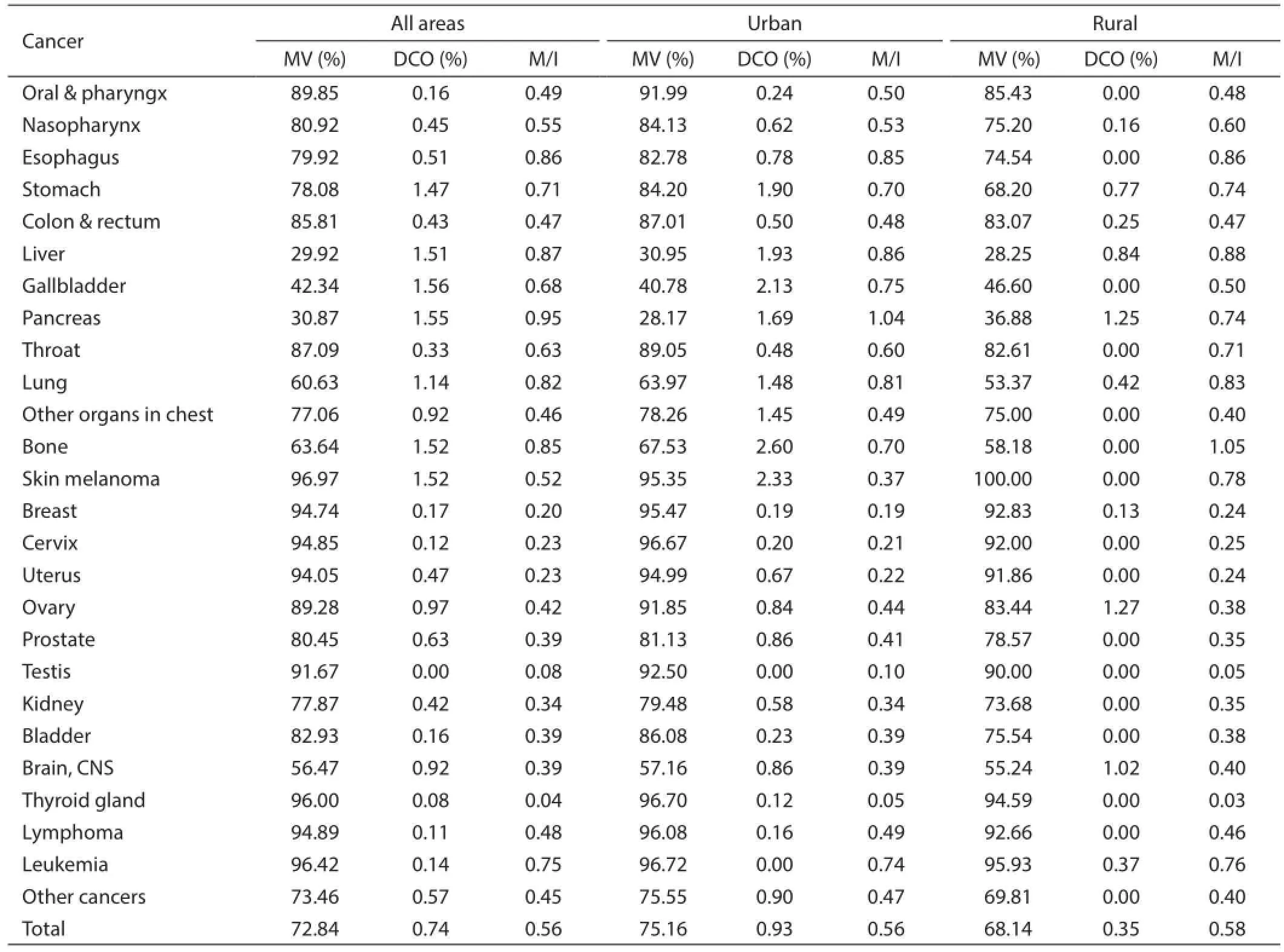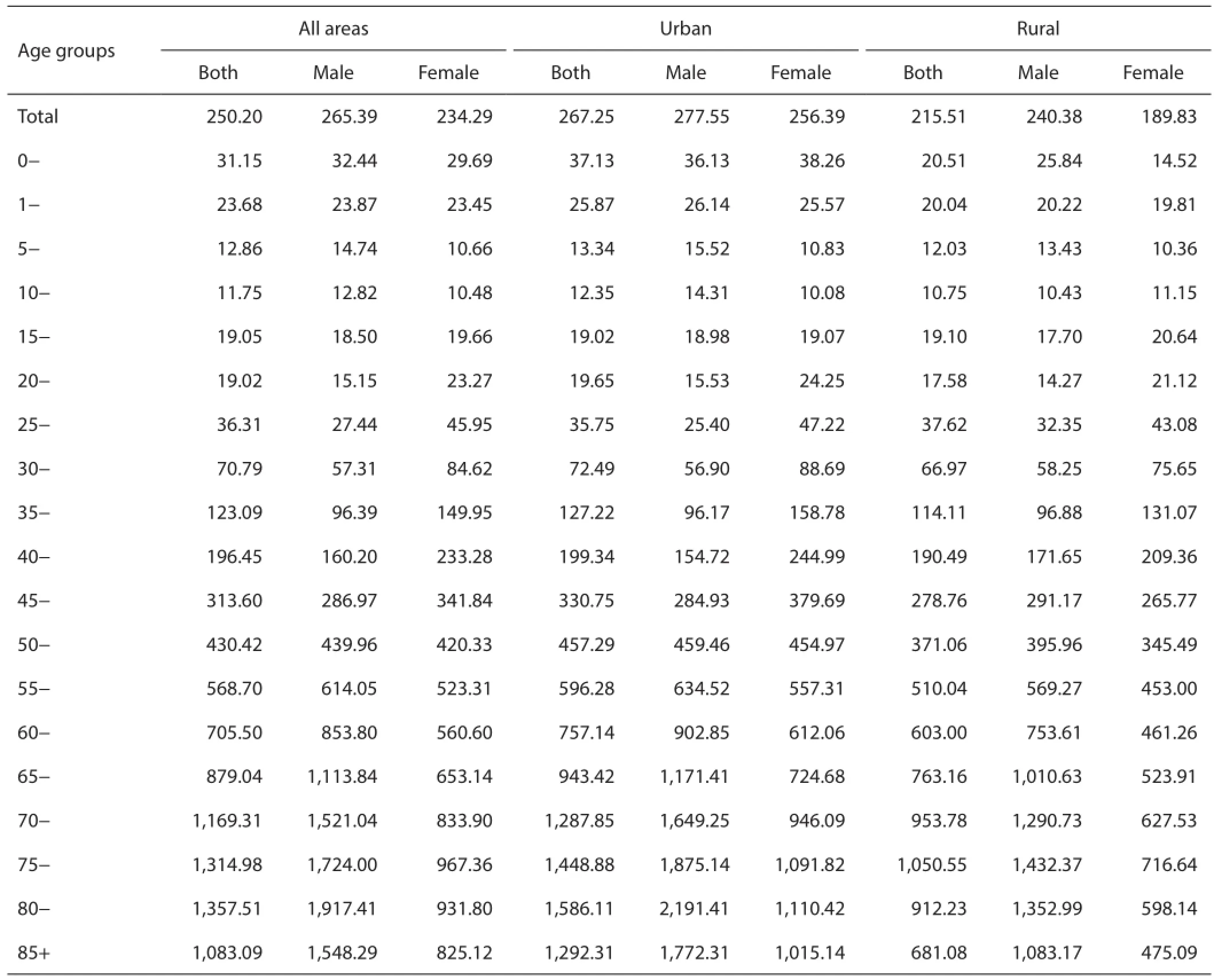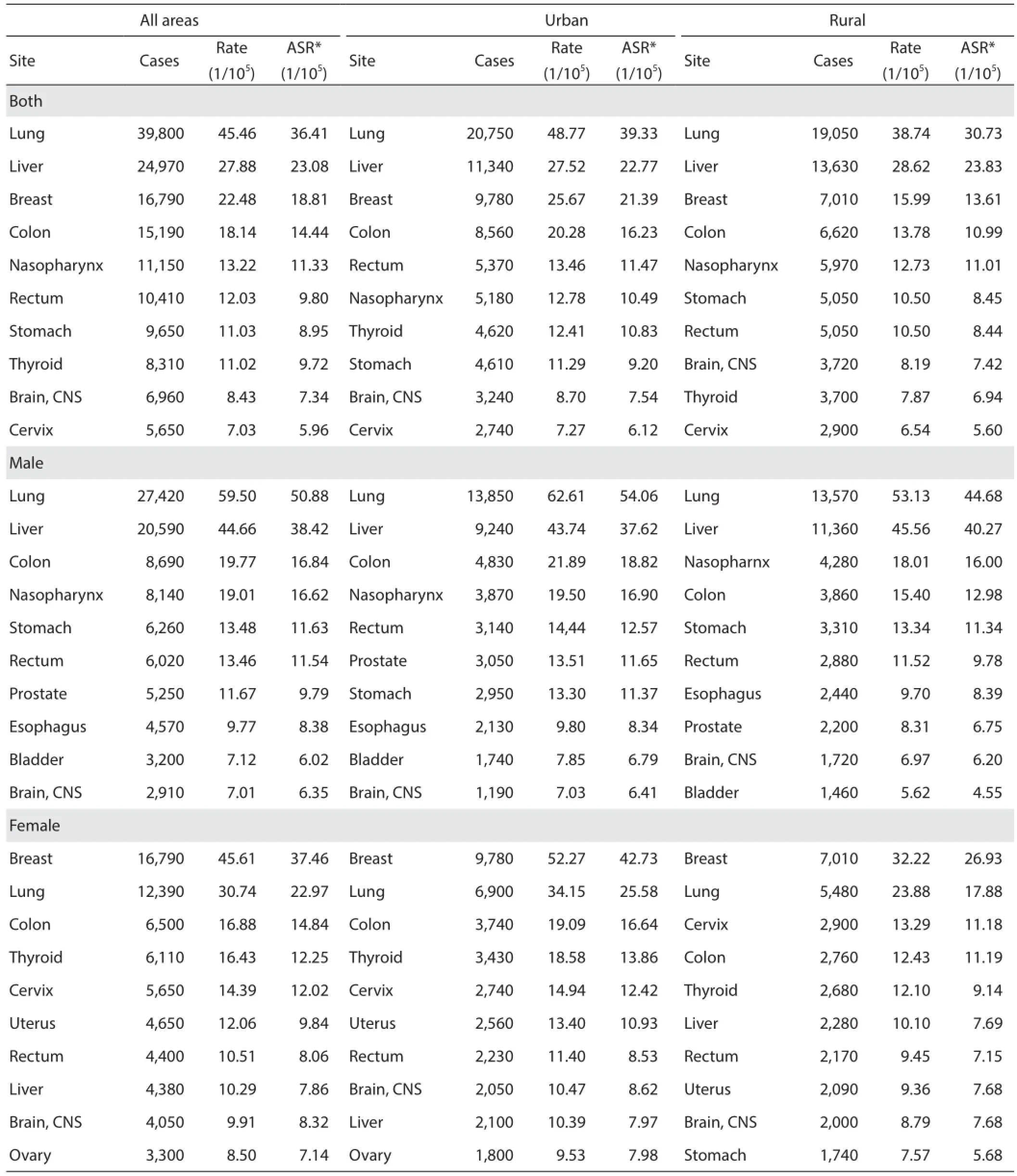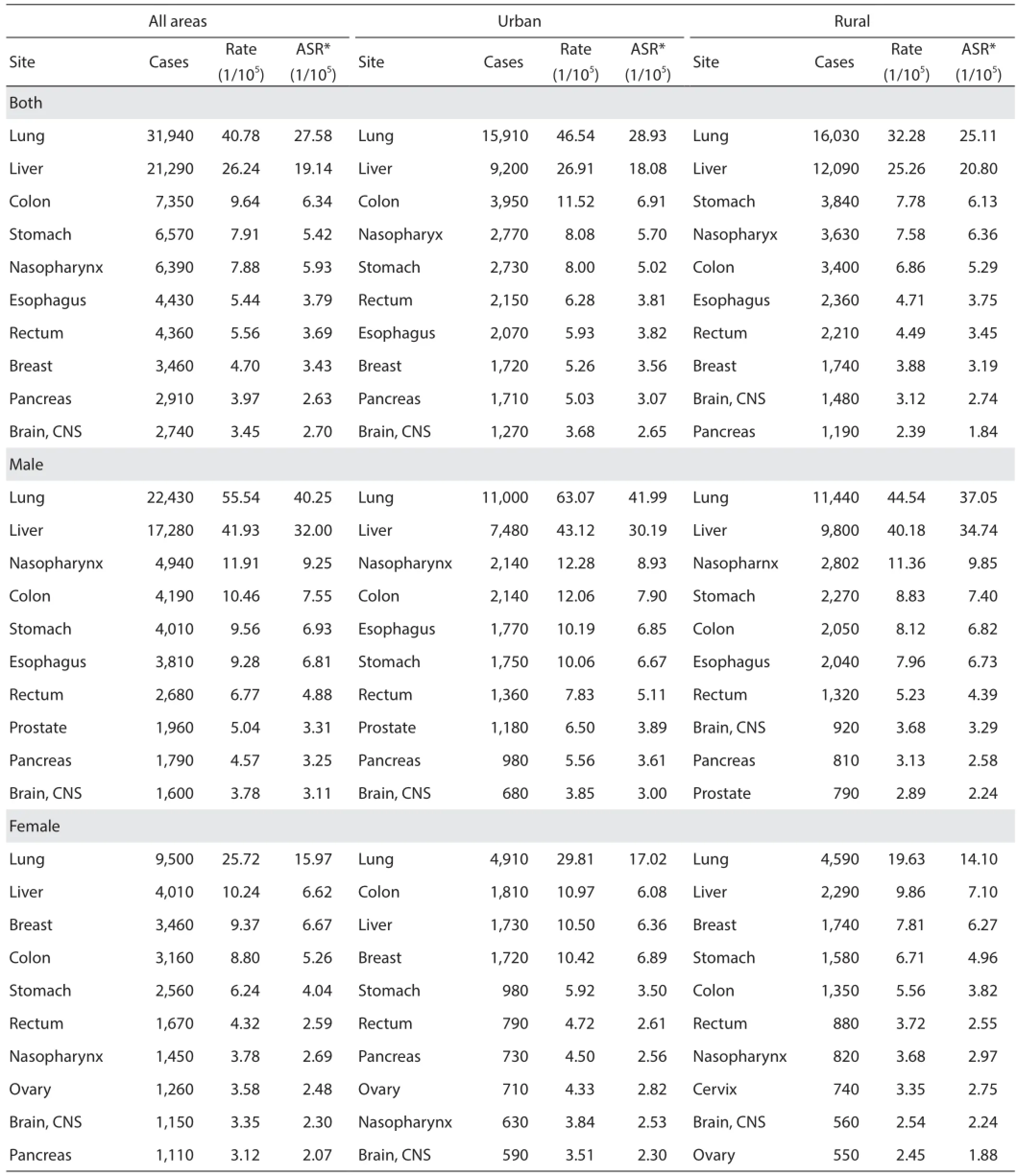Cancer incidence and mortality in Guangdong province, 2012
2016-07-28RuilinMengKuangrongWeiLiangXiaYanjunXuWanqingChenRongshouZhengLifengLinInstituteofControlandPreventionforChronicNoninfectiveDiseaseGuangdongProvincialCenterforDiseaseControlandPreventionGuangzhou540ChinaInstituteofCance
Ruilin Meng, Kuangrong Wei, Liang Xia, Yanjun Xu, Wanqing Chen, Rongshou Zheng, Lifeng LinInstitute of Control and Prevention for Chronic Non-infective Disease, Guangdong Provincial Center for Disease Control and Prevention,Guangzhou 540, China;Institute of Cancer, Zhongshan People's Hospital, Zhongshan 5840, China;Cancer Hospital, Chinese Academy of Medical Sciences, Peking Union Medical College & National Cancer Center, Beijing 000, China
Cancer incidence and mortality in Guangdong province, 2012
Ruilin Meng1, Kuangrong Wei2, Liang Xia1, Yanjun Xu1, Wanqing Chen3, Rongshou Zheng3, Lifeng Lin11Institute of Control and Prevention for Chronic Non-infective Disease, Guangdong Provincial Center for Disease Control and Prevention,Guangzhou 511430, China;2Institute of Cancer, Zhongshan People's Hospital, Zhongshan 528403, China;3Cancer Hospital, Chinese Academy of Medical Sciences, Peking Union Medical College & National Cancer Center, Beijing 100021, China
Correspondence to: Lifeng Lin. Institute of Control and Prevention for Chronic Non-infective Disease, Guangdong Provincial Center for Disease Control and Prevention, Guangzhou 511430, China. Email: 1396320174@qq.com.
Abstract
Objective: To estimate the cancer incidence and mortality in 2012 in Guangdong province by analyzing the cancer data of selected population-based cancer registries in Guangdong province in 2012.
Methods: Eight of nine population-based cancer registries submitted cancer data to the Guangdong Provincial Centre for Disease Control and Prevention (Guangdong CDC), whose data met the data quality criteria were included for analysis. The statistics of selected registries, stratified by areas, gender, age and cancer types, were used to estimate the cancer incidence and mortality in 2012 in Guangdong province according to the population data in Guangdong province. Segi's population and the national census population in 2000 were used for calculating the age-standardized rates (ASR).
Results: A total of 15,084,942 people, accounted for 17.47% of all population in Guangdong province, were covered in 8 selected population-based cancer registries in 2012. The percentage of cases morphologically verified (MV%) and the percentage of death certificate-only cases (DCO%) were 72.84% and 0.87%,respectively, and the mortality/incidence (M/I) ratio was 0.56. It was estimated that there were 211,300 new cancer cases and 117,300 cancer deaths. The incidence crude rate (CR), the ASR by Chinese standard population (ASRC) and by world standard population (ASRW), and the accumulated rate (AR) (0-74 years)were 250.20/100,000 (265.39/100,000 in males, 234.29/100,000 in females), 207.04/100,000, 201.34/100,000 and 22.91%, respectively, in Guangdong province in 2012. The incidence CR and ASRC were 267.25/100,000 and 221.43/100,000 in urban areas, and 215.51/100,000 and 178.77/100,000 in rural areas, respectively. The death CR, ASRC, ASRW and AR (0-74 years) were 148.44/100,000 (190.95/100,000 in males, 105.06/100,000 in females), 103.73/100,000, 102.44/100,000 and 11.68%, respectively, in Guangdong province in 2012. The death CR and ASRC were 164.57/100,000 and 105.46/100,000 in urban areas, and 124.63/100,000 and 99.97/100,000 in rural areas, respectively. Top 5 cancers were lung cancer, liver cancer, female breast cancer,colon cancer and nasopharyngeal cancers (NPC), and top 5 death cancers were lung cancer, liver cancer, colon cancer, stomach cancer, and NPC in Guangdong province in 2012.
Conclusions: Lung cancer, liver cancer, female breast cancer, colon cancer and NPC were the major economic cancer burdens and health concerns in Guangdong province in 2012. Early prevention, diagnosis and treatment of different cancers, survival quality improvement and cancer burden reduction, are important issues we faced in cancer control and prevention.
Keywords:Cancer registration; malignancy; incidence; mortality; Guangdong province
Submitted Mar 14, 2016. Accepted for publication Apr 12, 2016.
View this article at: http://dx.doi.org/10.21147/j.issn.1000-9604.2016.03.05
Introduction
Malignancy was the top one death cause in Guangdong province (1). Recently, along with the changing life styles,chronic infection, environment pollution, occupation exposure,psychological pressure, mental imbalance and population aging,cancer incidence and mortality were increasing. Populationbased cancer registration, continuously and systematically collecting the cancer data of incidence, mortality and survival of all registered population in given areas, provides information for cancer control and prevention as well as the basic and clinical research on cancer.
Located in southern China, developed and densely populated, Cancer registration in Guangdong province developed slowly since population-based cancer registration in Zhongshan and Sihui began in 1970s. That was why until now few researches on cancer burdens, such as incidence,death and survival in the whole Guangdong province were reported.
According to and by stratifying the cancer data of selected cancer registration areas in Guangdong province, the objective of this study was to estimate the cancer burdens in the whole Guangdong province under the current conditions of cancer registration in Guangdong province.
Materials and methods
Data sources
Cancer data in 2012 were collected from 9 population-based cancer registries in Guangdong in 2015 by the Guangdong Provincial Centre for Disease Control and Prevention (Guangdong CDC), 2 of which located in big cities (Guangzhou urban district and Shenzhen), 3 in medium-sized cities (Zhuhai,Zhongshan and Jiangmen), and 4 in rural areas (Guangzhou Suburb, Sihui, Yangshan and Nanxiong). The 9 cancer registries in Guangdong province in 2012 covered 15,628,343 people (8,012,947 in males and 7,615,396 in females).
Population data
The number of different age groups (0, 1-4, 5-9, 10-14,..., 85+), gender and areas (urban and rural) in Guangdong province in 2012 were deduced according to the populations of Guangdong province in 2012 issued by the Bureau of Statistics of Guangdong and the age distribution of population released by the Center of Statistics and Information of National Heath and Family Planning Commission.
Data quality evaluation
Data quality were checked and evaluated according to the criteria set by the Guideline for Chinese Cancer Registration (2), Cancer Incidence in Five Continents Volume IX (3) and International Agency for Research on Cancer/International Association of Cancer Registration (IARC/IACR) (4,5) by MSFoxPro, MS-Excel, SAS (SAS Institute Inc., Cary, USA), and IARCcrgTools software (IARC/IACR). Among the 9 cancer registries, the data of 5 registries, whose percentage of cases morphologically verified (MV%) ≥66%, percentage of death certificate-only cases (DCO%) <15%, mortality to incidence ratio (M/I) between 0.6-0.8 and others & unspecific (O&U)<5%, were accepted for analysis. Although not met the above data criteria, the data of other 3 registries were also accepted for analysis out of comprehensive consideration. In the 8 selected registries, 5 of them located in urban areas (Guangzhou,Shenzhen, Zhuhai, Zhongshan and downtown Jiangmen) and 3 in rural areas (Suburb Guangzhou, Sihui and Nanxiong).
Statistical process and indexes
The data of 8 cancer registries were merged and aggregated for analysis. The indices such as incidence and death crude rates (CR), the age-standardized rates (ASR) by Chinese standard population (ASRC) and by world standard population (ASRW),the accumulated rate (AR), and proportions by age, gender,areas and cancer types were calculated. The corresponding statistics in the whole Guangdong province in 2012 were estimated according the above stratified statistics and the population data in Guangdong province. Segi's population and the national census population in 2000 were used for calculating ASRW and ASRC, respectively.
Results
Data quality
A total of 15,084,942 people (7,720,472 in males and 7,364,470 in females), 10,113,576 in urban and 4,971,366 in rural areas,accounted for 17.47 percent of all population in Guangdong province at the end of 2012, were covered in the 8 selected population-based cancer registries. The MV% and DCO% were 72.84% and 0.87%, respectively, and the M/I ratio was 0.56 (Table 1).
Incidence
It was estimated that there were 211,300 new cancer cases (119,000 in males, 92,300 in females), 51.40% (108,600) of which in urban areas, 48.60% (102,700) in rural areas, and the CR, ASRC, ASRW and AR (0-74 years) were 250.20/100,000 (265.39/100,000 in males, 234.29/100,000 in females),207.04/100,000, 201.34/100,000 and 22.91%, respectively, in the whole Guangdong province in 2012 (Table 2).

Table 1 Quality evaluation of cancer registration data, 2012

Figure 1 Age-specific cancer incidence rate in urban and rural areas in Guangdong province, 2012.
Age-specif c incidence

Table 2 Cancer incidence in Guangdong province, 2012

Table 3 Age-specif c incidence rates of overall cancers in Guangdong province, 2012 (1/105)
The age-specific incidence rate was relatively lower before 40 years old, then increased dramatically and peaked at age group of 75-84 years (Table 3, Figure 1). The pattern was similar between urban and rural areas. The incidence CR of males and females reached the top at age group of 75 years, then decreased after the group of 80 years in rural areas, and peaked at age group of 80 years in urban areas.
Incidence of major cancers
Lung cancer, with 39,800 new cases, was the top one common cancer in Guangdong province in 2012, followed by cancers of liver, female breast, colon and nasopharynx. For males, lung cancer, with 27,400 new cases, was also the top one common cancer in Guangdong province in 2012, followed by cancers of liver, colon, nasopharynx and stomach. For females, the top one common cancer was breast cancer with 16,800 new cases,followed by cancers of lung, colon, thyroid and cervix.
In urban areas in 2012, lung cancer, with 20,750 new cases, was the top one common cancer, and next were cancers of liver, female breast, colon and rectum. For males, lung cancer, with about 13,850 new cases, was also the top one common cancer, followed by cancers of liver, colon, nasopharynx and rectum. For females,the top one common cancer was breast cancer with 9,780 new cases, followed by cancers of lung, colon, thyroid and cervix.
In rural areas, lung cancer, with about 19,050 new cases, was the top one common cancer, and next were cancers of liver,female breast, colon, and nasopharynx. For males, lung cancer,with about 13,570 new cases, was also the top one common cancer, followed by cancers of liver, nasopharynx, colon and stomach. For females, the top one common cancer was breast cancer with 7,010 new cases, followed by cancers of lung,cervix, colon and thyroid (Table 4).
Mortality
It was estimated that there were 117,300 cancer deaths (77,800 in males, 39,500 in females), 48.08% (56,400) of which in urban areas, 51.92% (60,900) in rural areas, and the death CR, ASRC, ASRW and AR (0-74 years) were 148.44/100,000 (190.95/100,000 in males, 105.06/100,000 in females),103.73/100,000, 102.44/100,000 and 11.68%, respectively, in the whole Guangdong province in 2012.
The death CR, ASRC, ASRW and AR (0-74 years) in urban areas were 164.57/100,000 (210.94/100,000 in males,117.65/100,000 in females), 105.46/100,000, 104.14/100,000 and 11.73%, respectively; 124.63/100,000 (161.76/100,000 in males, 86.29/100,000 in females), 99.97/100,000, 98.73/100,000 and 11.56% in rural areas, respectively. The death CR, ASRC and ASRW in urban areas were all higher than that in rural areas (Table 5).
Age-specif c mortality
The age-specific mortality rate was relatively lower before 45 years and then dramatically increased. Besides males in rural areas reached the peak at age group of 75 years, the females of both areas and the males in urban areas have reached the peak after 85 years (Table 6, Figure 2). The mortality in rural areas was higher before 5 years old. The age-specif c mortality of males in urban areas was lower than that in rural areas in most of age groups of 10-65 years,and for females, males in urban areas, it was higher than that in rural areas after 60 years, 70 years, respectively.

Figure 2 Age-specific cancer mortality in urban and rural areas in Guangdong province, 2012.
Mortality of major cancers
Lung cancer, with 32,000 deaths, was the top one death cancer in Guangdong province in 2012, and next were cancers of liver,colon, stomach and nasopharynx. For males, lung cancer, with 22,400 deaths, was also the top one death cancer, followed by cancers of liver, nasopharynx, colon and stomach. For females,the top one death cancer was lung cancer with 9,500 deaths,followed by cancers of liver, breast, colon and stomach.
In urban areas, lung cancer, with 15,900 deaths, was the top one death cancer, and next were cancers of liver, colon,nasopharynx and stomach. For males, lung cancer, with about 11,000 deaths, was also the top one death cancer, followed by cancers of liver, nasopharynx, colon and esophagus. For females, the top one death cancer was lung cancer with 4,900 deaths, and next were cancers of colon, liver, breast and stomach.
In rural areas, lung cancer, with about 16,000 deaths, was the top one death cancer, and next were cancers of liver, stomach,nasopharynx and colon. For males, lung cancer, with about 11,400 deaths, was also the top one death cancer, and next were cancers of liver, nasopharynx, stomach and colon. For females,the top one death cancer was lung cancer with 4,600 deaths,followed by cancers of liver, breast, stomach and colon (Table 7).

Table 4 Top 10 cancer incidence in Guangdong province by gender and areas in 2012

Table 5 Cancer mortality in Guangdong province, 2012
Discussion
This paper used the population data and cancer data from 8 population-based cancer registries in 2012 in Guangdong province, which were accepted for analysis according to the data quality criteria set by the National Center of Cancer Registries, to estimate the cancer incidence and mortality in the whole Guangdong province in 2012.
The estimated results showed that 211,300 cancer new cases and 117,300 deaths occurred in the whole Guangdong province in 2012. Compared with the rates in 2009 (6), the incidence and death CRs and ASRs in 2012 were increased and higher. The increasing trends were consistent with the recent national trends (7-9). Obvious disparity existed in cancer burdens between urban and rural areas of Guangdong province. Cancer incidence and mortality were much higher in urban areas than that in rural areas, and cancer type was also dif erent in the two areas. The incidence and mortality of colon and rectum cancers were much higher in urban areas than that in rural areas.
The incidence CR was 250.2/100,000 in Guangdong province in 2012, which was lower (9) but slightly higher after standardized than the national average rate, and the same was in the urban areas of Guangdong province, except for the rural areas, whose incidence CR and ASR were both lower than the national average rates. It is suggested that cancer incidence in the rural areas of Guangdong province was really lower than the national average rate, and the incidence rates in Guangdong province and its urban areas were both af ected by the population age structure.
The cancer death CR and ASR were 148.44/100,000 and 103.73/100,000 in Guangdong province in 2012, respectively,which were lower than the national average rates, and the same was in the rural areas of Guangdong province, except for the urban areas, whose death CR was slightly higher than the national average rate. The reasons for lower death rates in Guangdong province were probably that Guangdong province was one of developed areas with relative sufficient medical resources, high levels of diagnosis and treatment as well as cancer patients with better prognosis.
The age-specific incidence and mortality in Guangdong province and China had similar patterns, and the incidence increased quickly from 40 years old and the mortality from 45 years old. The peak ages of incidence and mortality in Guangdong province were 75 and 85+ years old, respectively,and the incidence peak age was a little younger than the national one, but the death peak age was a little older.
The top 5 common cancers in 2012 were cancers of lung,stomach, liver, colorectal, and esophagus (9) in China, but were lung, liver, female breast, colon, and nasopharyngeal cancers in Guangdong province, and differences existed between China and Guangdong province. NPC and female breast cancers were within the top 5 common cancers in Guangdong province, but not in China. Female breast cancer was the 6th most common cancer, but NPC was not in top 10 common cancers in China. Stomach cancer and esophageal cancer were within top 5 common cancers in China, but were only the 7th and 12th most common cancers, respectively, in Guangdong province,which had its own unique cancer spectrum.
The top 5 death cancers in China in 2012 were cancers of lung, liver, stomach, esophagus and colorectum (9), but were cancers of lung, liver, colon, stomach and nasopharynx in Guangdong province, with only top 2 cancers were the same in Guangdong province and China. Esophageal cancers was the 5th most common death cancer in China, but not in top 5 in Guangdong province, and NPC was in top 5 in Guangdong province, but not in China. Other cancers in top 5 were of the same types but not the same ranks, such as colorectal and stomach cancer, which were the 5th and 3rd most common death cancers in China, respectively, but the 3rd and 4th in Guangdong province.
With distinctive characteristics, NPC was estimated to be the 5th most common incident and death cancers in 2012 in Guangdong province. Its incidence and mortality were 13.22/100,000 and 7.88/100,000, respectively, which were much higher than the national average rates (10). NPC incidence and mortality in Zhongshan and Sihui, included in this study, were 1.51-2.48 times higher than the average rates of Guangdong province, and thus NPC incidence and mortality in Guangdong province in this study were probably overestimated. The results of 3 national retrospective alldeath causes surveys in China showed that although NPC mortality increased, the rank of NPC in cancer death cause in Guangdong province declined gradually, which was the 3rd,5th and 6th most common death cancer in 1970s, 1990s and 2000s, respectively (1).
Conclusions
In conclusion, lung cancer, liver cancer, colon cancer, female breast cancer and NPC were the major cancer burden and health concerns in Guangdong province. Early prevention,diagnosis, treatment of different cancers, survival quality improvement and cancer burden reduction were the important issues we faced in cancer control and prevention.

Table 7 Top 10 cancer mortality in Guangdong province by gender and areas in 2012
Acknowledgements
We sincerely thank the staffs in the National Center of Cancer Registration for their help while writing this paper and all staf s of cancer registries in Guangdong province for their diligent works.
Footnote
Conf icts of Interest: The authors have no conf icts of interest to declare.
References
1. Xu Y, Luo L, Xia S, et al. Mortality trend of cancer among residents in Guangdong Province. Hua Nan Yu Fang Yi Xue (in Chinese) 2011;37:12-6.
2. National Office for Cancer Prevention and Control,Center of Biostatistics, MOH, National Center for Cancer Registry. Guideline for Chinese Cancer Registration. Beijing: Peking Union Medical College Press, 2004.
3. Curado MP, Edwards B, Shin HR, et al. Cancer Incidence in Five Continents. Vol. IX. Lyon: IARC, 2008:1-837.
4. Larsen IK, Småstuen M, Johannesen TB, et al. Data quality at the Cancer Registry of Norway: an overview of comparability, completeness, validity and timeliness. Eur J Cancer 2009;45:1218-31.
5. Parkin DM, Bray F. Evaluation of data quality in the cancer registry: principles and methods Part II. Completeness. Eur J Cancer 2009;45:756-64.
6. Cao SM, Xu YJ, Lin GZ, et al. Estimation of cancer burden in Guangdong Province, China in 2009. Chin J Cancer 2015;34:594-601.
7. Chen W, Zheng R, Zhang S, et al. Annual report on status of cancer in China, 2010. Chin J Cancer Res 2014;26:48-58.
8. Chen W, Zheng R, Zeng H, et al. Annual report on status of cancer in China, 2011. Chin J Cancer Res 2015;27:2-12
9. Chen W, Zheng R, Zuo T, et al. National cancer incidence and mortality in China, 2012. Chin J Cancer Res 2016;28:1-11.
10. He J, Chen W. Chinese Cancer Registry Annual Report 2012. Beijing: Military Medical Science Press, 2012.
Cite this article as: Meng R, Wei K, Xia L, Xu Y, Chen W,Zheng R, Lin L. Cancer incidence and mortality in Guangdong province, 2012. Chin J Cancer Res 2016;28(3):311-320. doi:10.21147/j.issn.1000-9604.2016.03.05
doi:10.21147/j.issn.1000-9604.2016.03.05
杂志排行
Chinese Journal of Cancer Research的其它文章
- Cancer incidence and mortality in Shandong province, 2012
- Cancer incidence and mortality in Henan province, 2012
- Estimated cancer incidence and mortality in Hebei province, 2012
- Cancer incidence and mortality in Gansu province, 2012
- Incidence, mortality and survival of female breast cancer during 2003-2011 in Jiangsu province, China
- Comparing overall survival between first generation EGFR-TKIs and chemotherapy in lung cancer patients with Del19/L858R
